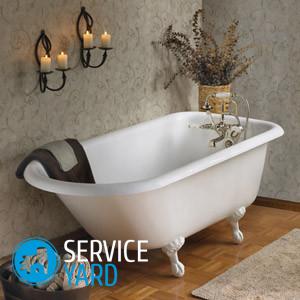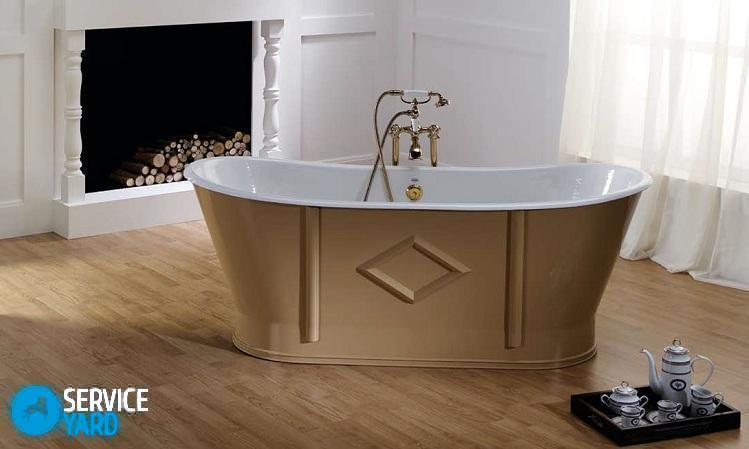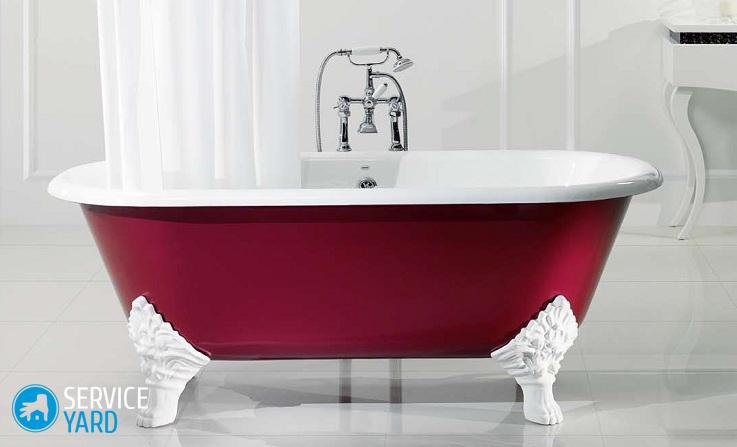How to repair a cast iron bathtub?

Many houses have a cast-iron bathtub - it could have remained since the days of the USSR, or you wanted it and installed it. The whole charm of such plumbing is that such fonts are incredibly reliable, practical, but like everything else in the world, they can acquire defects over time. The most common is enamel chips. Accordingly, it is necessary to know how to repair a cast-iron bath, and to do it right so that a solid font lasts a couple of decades. This will be the topic of this article.
to contents ↑Cast iron bath enamel
The warranty on the bathtub, which is made of cast iron, is slightly higher than the shelf life of its enamel. We often use a variety of abrasive powders and other chemicals that adversely affect the enamel coating of the bowl. Therefore, the most famous method of restoration is enameling, which is the most affordable and simple. It is with the help of it that you can easily and quickly hide the appeared roughness and yellow spots.
The advantages of this method of restoration:
- fairly low cost of the necessary substances and materials;
- no need to dismantle the bath;
- You can change the color of the bath by adding dye to the enamel;
- no need for subsequent repair processes;
- the method is suitable for both cast iron and steel baths.
Minuses:
- new enamel can last no more than 5 years;
- the composition, which is applied to the surface of the bath, dries for a very long time - at least 7 days;
- the new coating is quite tough, respectively - more sensitive to shock, which by itself leads to the formation of chips;
- the substance must be applied in a thin layer, so this enamel will not be able to hide irregularities, serious chips and dents;
- after a short amount of time, the enamel begins to turn yellow.
When the properties of the enamel coating are quite suitable for you, it will not be difficult for you to apply it to the surface. Consider how to repair a cast-iron bathtub in this way.
Prepare all the necessary tools:
- sandpaper;
- a drill with an appropriate type of nozzle such as a grinding wheel;
- abrasive powder;
- degreasing agent;
- lint-free natural napkin;
- two-component enamel;
- tassel.
Important! All work must be carried out in a respirator, as well as rubber gloves.
DIY enamel application:
- Sprinkle the bath with the abrasive powder of your choice, remove the old enamel with sandpaper or a drill.
- Rinse off the torn off enamel and chips by opening the tap.
- The surface of the bath is treated with a degreasing agent, and then wipe dry with a lint-free cloth.
- Fill the bathtub with hot water and hold it for at least 10-15 minutes. Once the time runs out, drain the water and wipe the bowl again with a dry, natural cloth.
- Be sure to make sure that the bathroom does not contain a variety of strings, villi.
- Prepare the enamel clearly following the instructions: mix the hardener and enamel in the appropriate proportions indicated on the package.
- Using a brush, apply the first layer of enamel to the surface of the bath.
- Leave to dry for the time specified in the instructions. Often it takes no more than 25-30 minutes.
- In exactly the same way, apply the second, and then the third layer of enamel, while not forgetting to leave time to dry.
to contents ↑Important! Experts note that it is possible to apply the fourth layer, which will be a fixative, but it is optional. You can use the updated bath no earlier than a week later.
Liquid acrylic: enamel as from the factory
A method of repairing cast-iron bathtubs using liquid acrylic appeared recently enough, but has already managed to gain some confidence among professionals.
Important! The new substance, which is called Stakril, allows you to get an excellent surface that hides all the shortcomings of the cast-iron bathtubs. The layer thickness varies from 3 mm to 6 mm.
Pros:
- viscosity means provides a reliable layer of new enamel;
- free flow provides an excellent even layer;
- high impact resistance and durability;
- high service life, which reaches two decades;
- affordable price.
Minuses:
- quite a laborious process;
- the cost is higher than ordinary enameling.
Important! Before you begin to work, remember that you can change the color of the bath by adding a certain amount of tint to acrylic.
The tools you need are exactly the same as for enameling.
The work is carried out as follows:
- Perform a thorough preparation of the cast-iron bowl, which is described in enamel - from 1 to 5 steps.
- Disconnect the siphon, to drain, put any container into which all excess acrylic will drain.
- Prepare liquid acrylic according to the instructions: mix the product with the hardener in the proportions specified by the manufacturer.
- Start pouring acrylic from absolutely any convenient tank on board.
Important! Acrylic on the bath must be poured continuously, so take a convenient and not quite small container.
- When the spray reaches about the middle, move the acrylic mixture around the entire perimeter of the bowl.
- When you return to the starting point, repeat the procedure from the middle of the surface, and again around the entire perimeter. Processing the bottom is necessary in the last turn.
- During operation, do not save a liquid product, all the excess will go into the container that you put under the drain, but the surface will ultimately be perfect, smooth and even, to hide all defects.
to contents ↑Important! The time for which acrylic hardens depends on the manufacturer. It usually takes 1-4 days. When choosing a liquid substance, pay attention to the one that has the longest drying time - this will provide higher quality new enamel.
Acrylic liner: brand new bathtub
This method is one of the most expensive, but it gives you the opportunity to get a completely new bath without having to purchase another product. To repair the bath cheaper, you can install it yourself.
Important! The insert will last you up to 16 years.
Pros:
- the restoration process is fast enough, without other costs;
- high life of the new bath;
- the surface is flat, smooth and attractive in appearance;
- The new bowl is extremely resistant to wear.
Minuses:
- the incredibly high cost of making a new acrylic bowl;
- installation of the insert must be carried out before the start of wall decoration, otherwise - you will have to knock down the old tile around the bath, and then mount a new one.
Important! In the case when the bathroom is still in the process of repair - this option is for you.
To get started, you will need tools:
- silicone sealant;
- mounting two-component foam;
- liner.
Work sequence:
- You order an insert at a company that can make an exact copy of your old bathroom.
- If the liner does not have a hole for overflow and drain - do it.
- Thoroughly clean the old bowl and then degrease it.
- Insert the insert into the bath, check the parameters, cut the sides if necessary.
- Apply mounting foam over the entire surface of the liner and over the entire inner surface of the cast-iron bathtub.
- Insert the acrylic liner; treat all joints with sealant.
to contents ↑Important! When you install the liner, immediately fill the bath with cold water, soak it for at least 1 day. After time, you can use the bath for its intended purpose.
Stock footage
Now you know several ways how to repair a cast iron bath with your own hands. We hope that one of the proposed options suited you both in terms of the cost of the work and the quality of the restoration, and you managed to complete the repair perfectly.
- How to choose a vacuum cleaner taking into account the characteristics of the house and coatings?
- What to look for when choosing a water delivery
- How to quickly create comfort at home - tips for housewives
- How to choose the perfect TV - useful tips
- What to look for when choosing blinds
- What should be running shoes?
- What useful things can you buy in a hardware store
- Iphone 11 pro max review
- Than iPhone is better than Android smartphones





